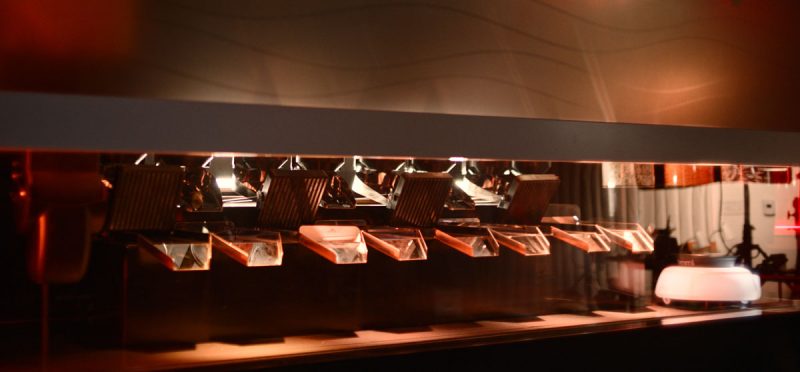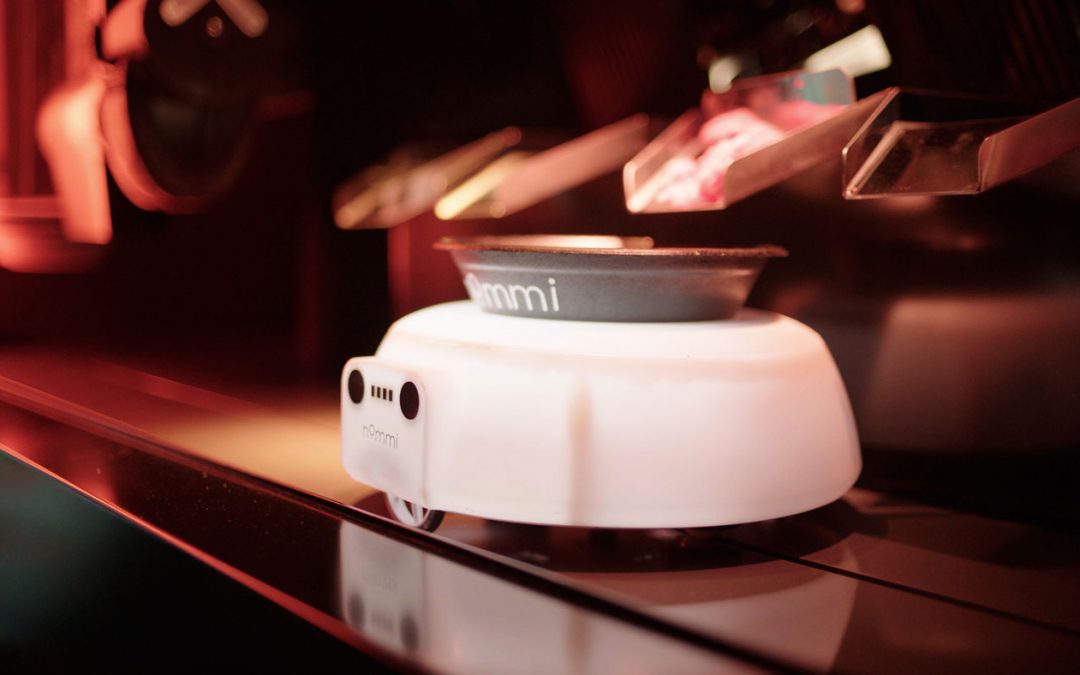There’s another new robot kid on the block: Nommi, a fully autonomous robotic kitchen designed to make Michelin-star-quality meals for a fraction of the cost. The promise has grabbed some big attention from Michelin star- and James Beard-winning chef Masaharu Morimoto as well as hospitality guru Sam Nazarian’s C3.
On the culinary side, Morimoto—one of the classic chefs from the campier era of competitive cooking television—is lending his culinary prowess in the form of recipes from his elevated Japanese restaurant Sa’Moto. The concept happens to be inside C3’s Citizens food hall, and the sprawling hospitality company will provide a test bed for a pilot program and has penciled in an order for 1,000 Nommi outlays.
“The sky is the limit through our partnership with Nommi to further expand C3’s food tech offerings,” said C3’s founder and CEO Sam Nazarian. “With Nommi, we are working to reimagine the restaurant experience by partnering artificial intelligence with proven recipes and menu’s helmed by C3’s world-renowned chefs.”
Between Nazarian and Morimoto, Nommi CEO Buck Jordan said the company is set up to scale fast.
“When we decide to go out and build the company, we really wanted to build this thing to win from day one, we wanted to stack the deck,” said Jordan. “We thought about what do we need for partners to make this a multi-billion-dollar outcome. One, we brought in C3 and Sam Nazarian, nobody knows restaurants like Sam.”
As a reality-TV foodie, however, Jordan said the Morimoto connection is especially exciting.
“I was such a fanboy before I started this business. [Morimoto] is going to make sure that the taste is unparalleled. At the end of the day, the only thing that matters is the taste, nobody cares if it was made by a robot, it’s got to taste good,” said Jordan. “Morimoto isn’t going to put his name on anything that doesn’t.”
Robot restaurant watchers probably recognize Jordan’s name, he’s the founder and CEO of Wavemaker Labs. Wavemaker is the technology incubator behind a handful of food-related automation companies including Piestro and Miso Robotics—the creator of Flippy.

Nommi co-founder and CEO Buck Jordan.
The partnership demonstrates how Jordan thinks about Wavemaker as a robotics expert, not a brand-builder like so many other robotic-focused concepts. Having Morimoto and his recipes keeps his team focused on engineering around that complexity.
“I think why a lot or robotic food companies fail is they take on more risk. They’re trying to make a world-class robotic product and a world-class brand. The team you need to create a world-class brand is the exact opposite of creating a world-class robot,” said Jordan.
Instead of changing the menu to fit the robot, his engineers change the robot to fit the cuisine—an important distinction.
Of course, there are labor considerations as well. Nommi is directly aimed at doing more with less, especially in the kitchen where labor is especially difficult. Jordan said restaurants today are currently operating with 2.8 fewer front-of-house employees and 6.2 fewer back-of-house employees, demonstrating that the kitchen is getting harder and harder to staff within restaurants.
Like Miso, Nommi will soon embark on a crowdfunding campaign under Reg A+ rules. The company seeks to raise $20 million from unaccredited investors with an initial $80 million valuation.
What’s novel in Nommi?
Looking at Nommi, you can see it’s essentially a robotic car carrying a bowl and a series of chutes that pour food into said bowl. As many robots, it’s deceptively simple but has some core tricks: customization and elevated presentation.
The core device can be customized to cook a wide variety of food—”anything you cook in a wok,” said Jordan. He’s starting with the massive pan-Asian category, a ubiquitous player in delivery and carryout, but there’s potential for Indian and all manner of bowl-based foods.

Nommi in the moody test kitchen.
It can hold up to 330 bowls and lids before requiring a refill and hold more than 20 prepared bowls after being made. It’s also designed for easy maintenance. Jordan said the goal is a half hour of service per day per machine.
The robotic car navigates under those chutes to catch the cooked food, but it also rotates the bowl to direct each ingredient to the right spot in the bowl. That’s one key feature and something a robotic arm like Flippy can’t do as well.
“I can’t take a tweezer today and place a basil leaf artfully on a bowl. But after negotiating with chef Morimoto, we can do precise ingredient placing in the bowl. That really affected our design. If you see the Nommi bot, it’s able to twist and move, and that means we can have tomatoes in this corner over here so it’s artful and special,” said Jordan.
The seemingly simple method also helps reduce cost and complexity of the devices, a chute and a little robot car are much cheaper than an industrial arm.
“Arms are great, we’ve certainly built lots of robotic products with arms. They’re great because they’re bulletproof, they’re built for factory environments. But arms are expensive, we’re really focused on bring this to the masses so these need to be affordable machines we can scale quickly. And I don’t want to deliver a $20 Morimoto grain bowls, I want a sub $10 bowl,” said Jordan.
The overall form factor is akin to Piestro, the all-in-one pizza-making kitchen. The small footprint reduces a lot of typical restaurant buildout costs.
“We are a fully automated kitchen when you go full auto it’s a massive labor savings but also a real estate savings. Now we don’t have to build out a kitchen and spend the capex installing hoods, it’s a kitchen in a box and probably less than a quarter of the size,” said Jordan. “You really just need a space with a 220-volt plug. So now where you can put these things is up to your imagination.”
That’s a clear advantage for the growing dark kitchen sector where Jordan sees a Nommi machine spitting out food at all hours with very limited upkeep by operators.
The cost of the device is not yet public, but there will be upfront costs as well as a subscription fee much like Flippy and other robotic kitchen products. The details will come into view as Nommi approaches the market. There’s plenty of work still to do. Jordan said it can cook and operate, but it’s very much a prototype. He’s looking for a beta unit later in 2022 and a production version coming in 2024.
Go check out a video introducing the concept with Morimoto and Jordan discussing the details at Nommi.co.


